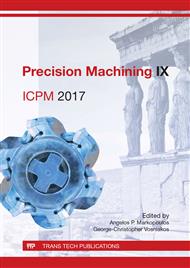[1]
J. P. Womack, D. T. Jones: Lean thinking, Simon & Schuster Inc., (2008).
Google Scholar
[2]
J. Cselényi, B. Illés: Planning and controlling of material flow systems. Textbook, Miskolci Egyetemi Kiadó, (2006).
Google Scholar
[3]
H. Mapfaira, M. Mutingi, V. P. Kommula, D. Baiphisi, M. Kemsley: Productivity improvement using simulation modelling and lean tools, International Journal of Engineering Sciences & Research Technology, ISSN: 2277-9655, (2016).
Google Scholar
[4]
A. Aravinthkumar, D. Rajenthirakumar: Lean Tools and Techniques Implementation in a Manufacturing Industry, Journal of Applied Sciences Research November (2015).
Google Scholar
[5]
A. Mahfouz, A. Arisha: Lean distribution assessment using an integrated model of value stream mapping and simulation, Proceedings of the 2013 Winter Simulation Conference.
DOI: 10.1109/wsc.2013.6721707
Google Scholar
[6]
Tamás. P., Illés, B., Tollár, S. (2012): Simulation of a flexible manufacturing system. Adv. Logistic System Theory and practice, Volume 6., HU ISSN 1789-2198, pp.25-33.
Google Scholar
[7]
M. Rother, M. J. Shook: Learning to See: Value Stream Mapping to Add Value and Eliminate Muda, Lean Enterprise Institute, (2003).
Google Scholar
[8]
S. Shingo: A Revolution in Manufacturing: The SMED system. Productivity Press, (1985).
Google Scholar
[9]
B. Ulutas: An application of SMED Methodology, International Journal of Mechanical, Aerospace, Industrial, Mechatronic and Manufacturing Engineering Vol. 5, No. 7, (2011).
Google Scholar
[10]
Kosztolányi, J., Schwahofer, G. (2012): Kanban, KAIZENPRO Oktató és Tanácsadó Kft., ISBN: 9789638962065.
Google Scholar
[11]
A. P. Markopoulos, A. Fragkou, P. D. Kasidiaris, J. P. Davim: Gamification in Engineering Education and Professional Training, International Journal of Mechanical Engineering Education, Vol. 43(2), pp.118-131.
DOI: 10.1177/0306419015591324
Google Scholar
[12]
E. B. Mohamad, T. Ito: Integration of e-learning and simulation to user training programme of SMED, International Journal of Internet Manufacturing and Services, Vol. 3(2) 2013. DOI: 10. 1504/IJIMS. 2013. 058716.
DOI: 10.1504/ijims.2013.058716
Google Scholar


